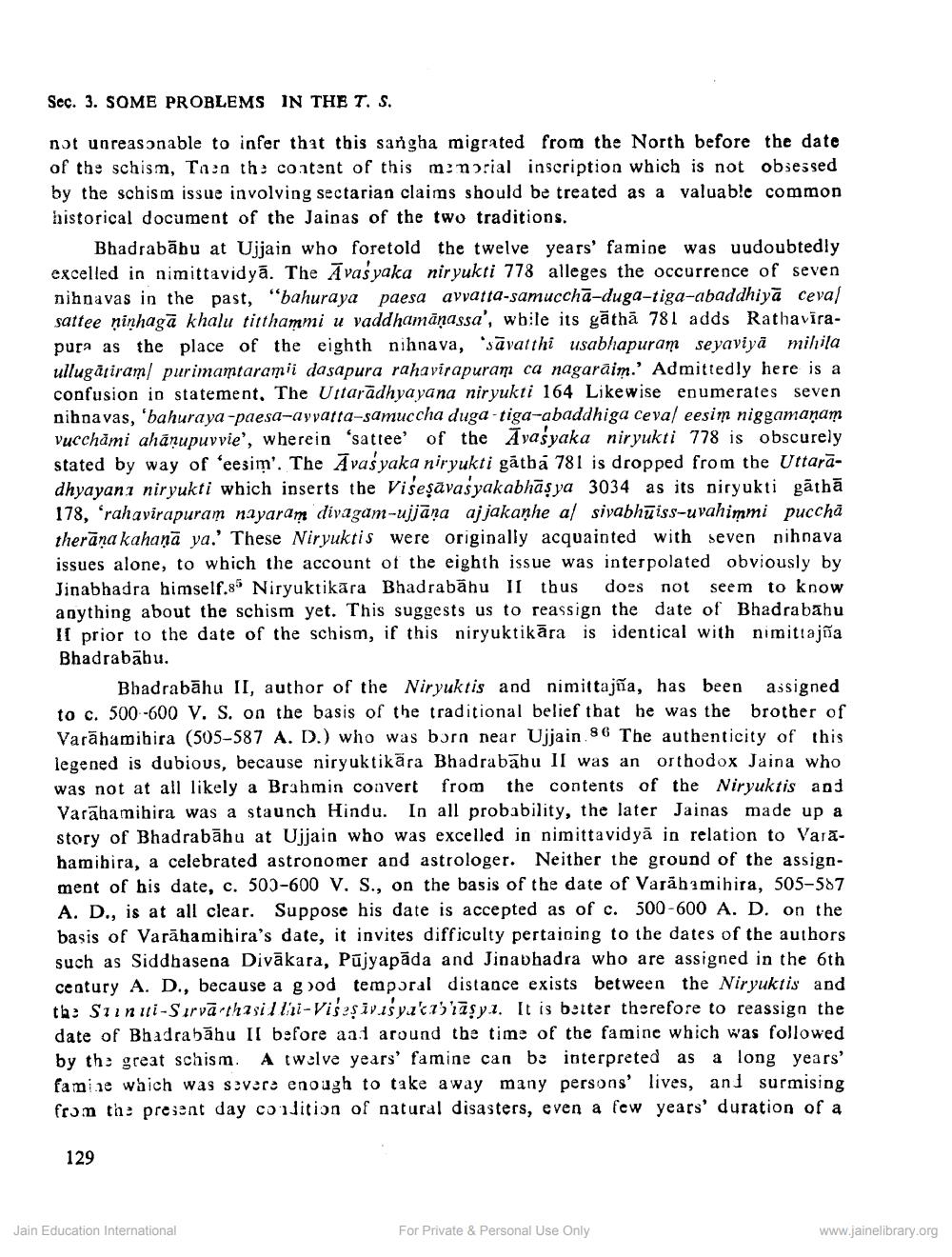________________
Sec. 3. SOME PROBLEMS IN THE T. S.
not unreasonable to infer that this sangha migrated from the North before the date of the schism, Taen the content of this memorial inscription which is not obsessed by the schism issue involving sectarian claims should be treated as a valuable common historical document of the Jainas of the two traditions.
Bhadrababu at Ujjain who foretold the twelve years' famine was uudoubtedly excelled in nimittavidya. The Avasyaka niryukti 778 alleges the occurrence of seven nihnavas in the past, "bahuraya paesa avvatta-samuccha-duga-tiga-abaddhiyā ceval sattee nighaga khalu titthammi u vaddhamaṇassa', while its gathā 781 adds Rathavirapura as the place of the eighth nihnava, sävatthi usabhapuram seyavlya mihila ullugatiram purimamtarami dasapura rahavirapuram ca nagaraim.' Admittedly here is a confusion in statement. The Uttaradhyayana niryukti 164 Likewise enumerates seven nihnavas, 'bahuraya-paesa-avvatta-samuccha duga-tiga-abaddhiga ceval eesim niggamanam vucchami ahanupuvvie', wherein 'sattee' of the Avasyaka niryukti 778 is obscurely stated by way of 'eesim'. The Avasyaka niryukti gatha 781 is dropped from the Uttaradhyayana niryukti which inserts the Viseṣavasyakabhasya 3034 as its niryukti gāthā 178, rahavirapuram nayaram divagam-ujjana ajjakanhe al sivabhuiss-uvahimmi puccha therana kahana ya.' These Niryuktis were originally acquainted with seven nihnava issues alone, to which the account of the eighth issue was interpolated obviously by Jinabhadra himself.85 Niryuktikara Bhadrabahu II thus does not seem to know anything about the schism yet. This suggests us to reassign the date of Bhadrabahu If prior to the date of the schism, if this niryuktikāra is identical with nimittaja Bhadrababu.
Bhadrabahu II, author of the Niryuktis and nimittajña, has been assigned to c. 500-600 V. S. on the basis of the traditional belief that he was the brother of Varahamihira (505-587 A. D.) who was born near Ujjain 86 The authenticity of this legened is dubious, because niryuktikara Bhadrabahu II was an orthodox Jaina who was not at all likely a Brahmin convert from the contents of the Niryuktis and Varahamihira was a staunch Hindu. In all probability, the later Jainas made up a story of Bhadrabähu at Ujjain who was excelled in nimittavidyä in relation to Varahamibira, a celebrated astronomer and astrologer. Neither the ground of the assignment of his date, c. 500-600 V. S., on the basis of the date of Varahamihira, 505-587 A. D., is at all clear. Suppose his date is accepted as of c. 500-600 A. D. on the basis of Varahamihira's date, it invites difficulty pertaining to the dates of the authors such as Siddhasena Diväkara, Pujyapada and Jinabhadra who are assigned in the 6th century A. D., because a good temporal distance exists between the Niryuktis and the Saint-Sarva-thasil Li-Vis riyakabasya. It is better therefore to reassign the date of Bhadrabahu II before and around the time of the famine which was followed by the great schism. A twelve years' famine can be interpreted as a long years' famine which was severe enough to take away many persons' lives, and surmising from the present day condition of natural disasters, even a few years' duration of a
129
Jain Education International
For Private & Personal Use Only
www.jainelibrary.org




